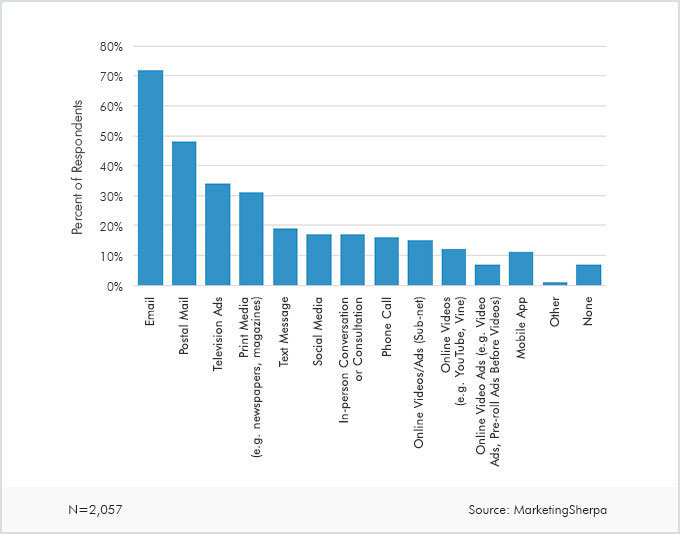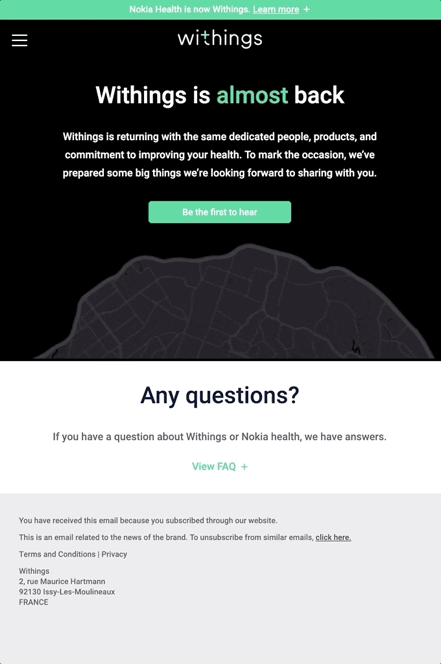The pace of innovation and the number of resources available to marketers today is nothing short of incredible, and we’d like to explain the benefits email delivers to grow your business.
An astounding 1,876 companies across 43 different marketing categories, including SEO, social, video marketing, sales enablement, mobile analytics, and dozens more exist according to VentureBeat. What’s more, many of the categories didn’t exist in the report just one year earlier.
But just one category continues to perform well year after year: email marketing. The reason is clear: For ten years in a row, email has generated the highest ROI for marketers. For every $1 spent, email marketing generates $40 in ROI and gives marketers the broadest reach of all the channels available to them. Despite the plethora of tools available to marketers, email marketing is simply the best bet for business growth.
The top reasons email delivers for your business
Today’s marketers need to do more with less. They need to connect with their audience in a highly personalised way while staying on budget. Marketers that can do this—connect with their prospects and customers in a highly targeted way—will be successful in delivering ROI and revenue back to the business.
As the VentureBeat report illustrates, no marketing category has the longevity of email marketing. While some marketing trends come and go, email remains the most powerful channel available to the modern marketer. It remains the best digital channel for ROI.
Here are 7 reasons why:
1. Email has a larger reach.
With Facebook boasting over 1 billion active users and Twitter boasting 255 million, it’s tempting to believe that social media is the most effective way to reach the masses. These are impressive numbers, but what isn’t so frequently shared are the statistics on email usage.
The total number of worldwide email accounts is projected to be 4.481 billion by 2024, according to Statista.
While this might seem surprising at first, think about your online behaviour: When you sign up for a website (like an online store), you have to enter your email address to create the account. You even need an email address to create a Facebook or Twitter account. What’s more, Facebook and Twitter email to notify users of activity, like when someone is tagged in a photo.
Email is the currency of the web, and anybody who’s online has an active email address. And while Facebook and Twitter might seem pretty ubiquitous, the ongoing struggle over data breaches and privacy means plenty of people are exiting some social media channels.
So when it comes to connecting with your prospects and customers, there’s no channel with a wider reach than email.
There are 3x more email accounts than there are Facebook & Twitter accounts combined.
2. Email delivers your message.
If marketers have to choose between adding a subscriber to their email list or gaining a new Facebook fan, they should go for the email subscriber every time.
There are two key reasons why:
First, 90% of emails get delivered to the intended recipient’s inbox, whereas only 2% of your Facebook fans see your posts in their News Feed. This is because Facebook limits the number of times your posts appear in the News Feed in an attempt to drive brands towards their paid advertising options.
This is a big deal when it comes to getting your messages in front of your desired audience.
On Facebook, if you post an update to your 10,000 fans only about 200 of them will even have a chance of seeing it in their News Feed. Alternatively, if you send an email campaign to 10,000 subscribers at least 9,000 of them will receive it in their inbox.
This means your message is 45 times more likely to be seen using email than Facebook.
Secondly, your email subscribers have explicitly told you they want to hear from you when they sign up for your email list.
There are strict laws and regulations around SPAM laws, so if you’re emailing a prospect or customer, it’s because they gave you their permission. Now think about the ads in your Facebook News Feed – did you ask those companies to market to you?
Probably not. More than likely, you performed a Google search or visited their website. That’s decidedly different than proactively signing up to receive emails from your preferred retailers.
Email is proven to ensure your audience gets your message.
3. Email drives conversions.
Most marketers are laser-focused on driving conversions. Regardless of whether they do so in the form of leads, sales, memberships, or a metric unique to your business strategy, the ultimate goal for marketers is to turn potential customers into paying customers.
And when it comes to conversions, there isn’t a more powerful channel than email.
The average click-through rate of an email campaign is around 2.6% (of total recipients), whereas the average click-through rate from a tweet is around 0.5%.
This means you are 6x more likely to get someone to click through to your website via email than you are from Twitter. As discussed earlier, your email subscribers have told you they want to hear from you and this isn’t typically the case with social.
4.24% of visitors from email marketing buy something as compared to 2.49% of visitors from search engines and 0.59% from social media, according to a survey conducted by Monetate.
What’s more, email is highly measurable. SwiftERM customers have real-time access to metrics like CTR, attributed sales, percentage attributed, and more.
As a marketer focused on nurturing leads and driving conversions—as most marketers are—email marketing trumps all other communication channels for business.
4. Email has a higher ROI.
Given email’s unmatched ability to drive conversions, it makes sense that email is also the most effective marketing channel to drive ROI for your company. Email marketing yields an average 3800% return on investment for businesses and for every $1 spent on email marketing, the average return on investment is $40, according to Lyfe Marketing
It’s clear from these statistics that email is a cost-effective channel for marketers, but why does it outperform other channels so significantly when it comes to ROI?
It comes down to delivering hyper-personalised and relevant messages. Unlike social networks where you send status updates to every follower regardless of their location, interests & purchase history, email allows you to be hyper-targeted with your communications. The more data you have about your customers in an email marketing tool like the top 30 vendors listed in our survey, – including unique data personal to each consumer, pulled in from your platform’s purchases history and impressions captured, the more lucrative the returns are.
Hyper-personalisation solutions are wholly autonomous and deliver exactly the right products in front of the consumer to whom they are entirely relevant at exactly the right time. For example, they know the tastes and preferences of that consumer, so they can ensure that individual details about bathing suits when they have illustrated their interest through looking at them 3 times already that month without yet buying.
It does not need to segment audiences, long since considered an antiquated practice in light of being able to personalize content. The product details they send are relevant to every individual recipient and that relevance drives people to click through, make purchases – and increase the ROI of their email marketing campaigns.
5. Email is the preferred communication channel.
For many, social networks are a personal form of communication used to keep up to date with friends & family. When people log in to their social media accounts, they’re there to see photos and updates from people they know and care about.
Email, on the contrary, is a much more professional medium and people expect to receive information about products and services through that channel.
Studies show 72% of people prefer to receive promotional content through email, compared to 17% who prefer social media.

6. Email is an open platform.
Over the past few years, many brands have invested millions of dollars into buying large social followings to be able to communicate and engage with an audience.
But while businesses are investing in various social media platforms, Facebook has frequently updated its algorithm to reduce the number of followers who will see a brand’s post, unless those posts are paid advertisements.
This practice has become so prevalent that 98% of brand followers will never see the posts in their News Feeds. Twitter seems to be moving in a similar direction with the announcement it will introduce an algorithm-controlled feed as well.
The issue with channels like Facebook and Twitter is they’re owned and controlled by third parties which means marketers are at the mercy of changes the platforms make to their platform.
Meanwhile, email isn’t owned or controlled by any one particular entity. It’s an open communication platform and there is a multitude of services that provide access to send and receive an email.
The diverse array of companies involved in email marketing ensures that no one party can make changes that would have a widespread effect, and unlike Facebook or Twitter, if you invest the time and money into building and cultivating a great email list, your subscriber list will be an asset you own. Therefore you’ll be able to leverage your list without the threat of someone limiting its effectiveness.
7. Email will be around forever.
Remember MySpace? What?
The once-hot site was the largest social networking site in the world between 2005 and 2008, and in June 2006 surpassed Google as the most visited website in the United States. Yet where is MySpace now? All those users eventually moved on to other social networks, and the site is now the 1,500th most popular website in the United States.
Imagine investing significant amounts of time and money to build an audience on a platform only to find it a ghost town just a year or two later. The impact on your ability to reach and engage potential customers would be catastrophic.
On the other hand, email has a long history of stability. The first promotional email campaign was sent in 1978 to a total of 400 people and email has been growing consistently since.
Interestingly, the email space itself has evolved from a time when you needed a developer to build an email to today, where hyper-personalisation tools empower the modern marketer to enormous levels of additional revenue from their emails with ease. This shift has put the power of business email into the hands of more people.
Building your email list, unlike building a social media following, is a stable long-term investment that will pay off for many years to come. Hyper-personalisation solutions help you calculate the viability of acquiring new customers, as well as details of how to get new customers. A useful tool for finding the email addresses of people you need to find is available by using Hunter, who explains how to know if someone has read your email.
Email marketing comes of age
Ready to kick your email marketing up a notch with the latest trends and innovations?
This is an exciting year in tech because of the changes it’s bringing to email marketing. Technological advancements create new possibilities in the ever-increasing ability to predict imminent purchases and equally obliterate the need for irrelevant content.
Interactive content is finally here.
Email marketing is no longer about broadcasting a message. Rather, it’s about crafting an experience for your subscribers.
We’ve known for a while now that relevant content boosts engagement rates by as much as 70% or more. We’re now beginning to see the use of interactive content to invite customers to experience brands on an entirely new level. Hyper-personalisation software runs in addition to marketing and promotional email software, which is required for this feature. Yes, you use both, permanently, together.
This year will embrace this potential even more fully. Expect to see the inclusion of dynamic design features and the gamification of engagement as marketers find new, exciting ways to keep subscribers hooked and converting.
Consumers emphasize beliefs, values, and connections.
This year, being real matters. Consumers want to see an authentic identity and a genuine commitment to your cause.
A brand’s ability to communicate its values and inspire genuine connection with its consumers will be among the most critical elements determining its survival in the upcoming year as consumers place even more importance on a company’s beliefs and values.
Over 60% of consumers now base their purchasing decisions on whether or not a brand shares their values. Furthermore, these consumers aren’t fooled by vague promises and catchy phrases: They want to see that you’re walking your talk.
You must optimize everything for mobile.
If your message, email, or webpage doesn’t work on mobile, it doesn’t work. At the end of last year, Newsday reported that over half of all emails are read on mobile devices. Yet, almost half of those emails weren’t formatted for a mobile display.
Mobile compatibility is now mandatory if you want to achieve a flawless presentation of your message. This year, strive to ensure that your design and your content display perfectly on every device, like this one from Withings:

Source: Really Good Emails.
Trigger-based email campaigns are powerful and convenient.
The use of automation for email campaigns is a lifesaver for many marketers. Such technology tracks a subscriber’s interaction with an email or a site and then sends out emails based on that behaviour, another explanation of the benefits email delivers to grow your business.
The retailer can enjoy the luxury of not requiring staff to handle anything involved in consumers receiving exactly the right products for them at exactly the right time, one huge headache less, without any chance of error or omission.
You’ll send more targeted, more effective emails and it will take you even less time.
How to stand out when everything is hyper-personalised.
Last year, personalization reigned supreme. And it will remain an important part of any successful email campaign.
However, when everything is hyper-personalised, how do you stand out?
Marketers face the challenge of establishing familiarity with their customers without sounding chummy or creepy. Part of achieving and maintaining this balance will involve a continued focus on the effort to humanize your interactions. No two consumers are alike, their DNA is different, and their life experiences are different. Celebrate that uniqueness by respecting it and all it offers but ensuring what you offer is pertinent and unique.
Conclusion
As a marketer, you have many channels available to reach your audience, but with limited time and resources, you need to prioritize your efforts. For the many reasons listed above, email marketing is by far the most effective channel to attract, engage, and connect with an audience to drive sales and revenue for your business.





